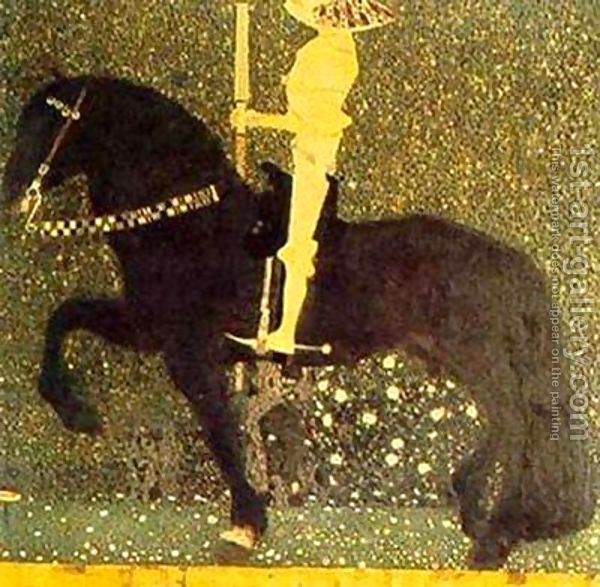Gold Cavalier
Skilled and passionate artist, Gustav Klimt, encompassed an array of metallic techniques and textures to create the painting Gold Cavalier.
The painting incorporates an array of materials to create the bronze piece of art, a common practice known as Klimt's gold phase. Upon completion of art school in Vienna, Klimt was hired to paint realist murals. His artwork was prominent within the 19th century as he was able to paint portraits in an in depth array of detail, however the artist transcended his work through the movement in Vienna towards Art Nouveau.
The artist's father was a gold engraver and had taught his son how to work with the precious metal. The Byzantine mosaics fascinated Klimt; influencing his style to use more bronze colours. Klimt incorporated tiny coloured pieces of glass, shiny stone and metallic materials to generate beautiful pieces of art that illustrated themes of the medieval time and Victorian era. The artist is known for his gold coloured work, which symbolized aspects beyond the real world. Bright colours and swirling lines were know to be a part of his Art Nouveau stage, which translate to ÔNew Art'. Klimt is a forefather within the style, and his gold styled painted are praised through decades.
The piece, Gold Cavalier, illustrates a knight standing on a black coloured horse. An immense amount of information behind the piece remains unknown, however, the painting illustrates a history of style and technique. The knight within the painting seems to be hand carved and sculpted. It is most likely that Klimt himself had carved the piece of gold and assembled it upon the canvas. However as Klimt's work became prominent, he worked on Byzantine projects with his colleagues where a specific team of carvers and sculptor were used the pieces. It remains unknown whether the whole piece is made of gold or just the outer layer of the knife.
A dark black horse is painted beneath the knight, with on leg up in an on guard position. The horse seems to be an oil on canvas piece, where Klimt gently mended with the metallic materials on the canvas. Klimt's in detailed craftsman ship illustrates the fur of the horse, as his light brushstrokes illustrate the texture of the animal. The horse is decorated with gold details to accessorize the piece, while illustrating the wealth of the knife.
The background of the painting is covered in a mosaic pattern of gold material. Little spots of gold and bronze cover the canvas, accentuating the background as a classic trademark of Klimt's gold phase. The material used for the background is either small metallic pieces of gold, or gold leaves which the artist common used. The bronze and gold colour scene upon the dark background creates a classic mixture of colour as one accentuates the other. The luxurious piece offers a trademark of Klimt's impeccable technique and art nouveau style.




